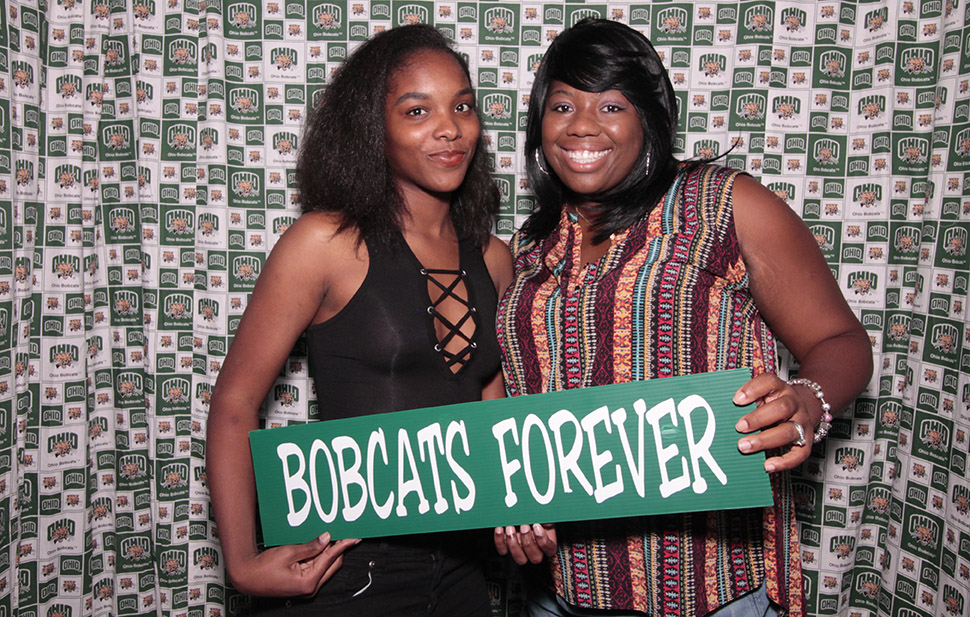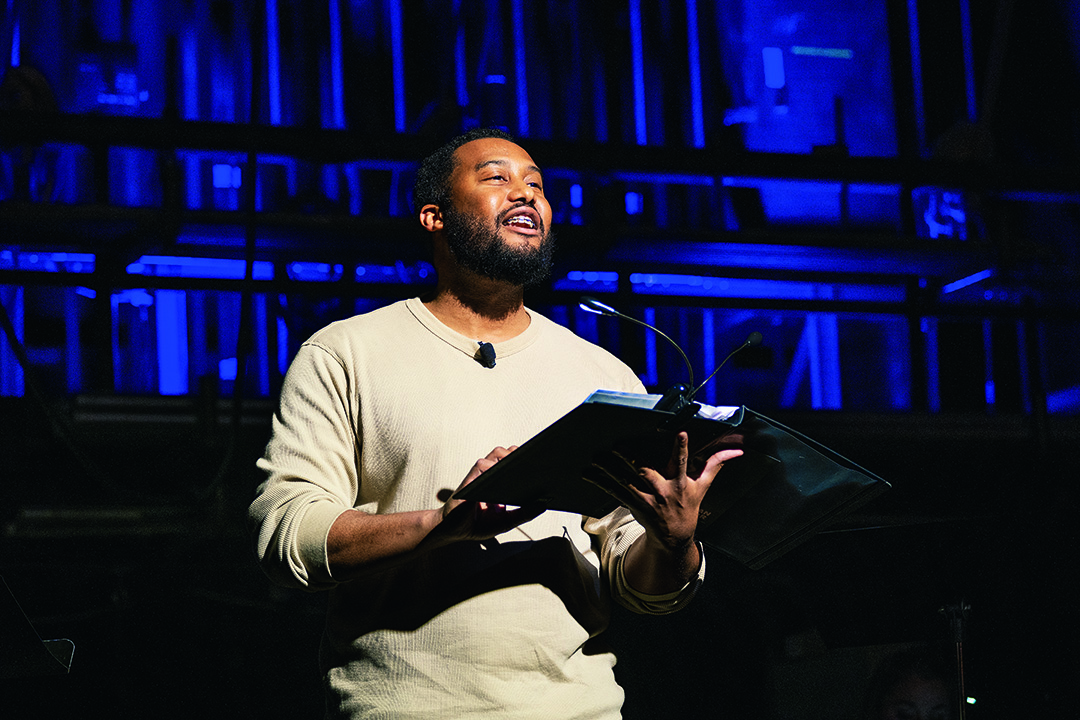
When John Newton Templeton enrolled at Ohio University in 1824, he wasn’t just the first African American student at the University; he was the only one. Two hundred years ago, what is now called Cutler Hall was the only campus building and served all functions: classroom, library, dormitory. But Templeton did not live with his handful of classmates, as he probably wasn’t permitted to. Instead, he lived in the home of Ohio University President Robert Wilson, where historians say he likely worked as a servant to pay for his education.
While Cutler Hall provided the immediate backdrop to Templeton’s time at OHIO, the American political landscape created the broader backdrop. Locally, newspaper ads offered rewards for those who had escaped slavery. It was 41 years before slavery would end in the United States, and Southern states were passing laws to prevent African Americans from learning to read.
History in the Making
Templeton himself was born into slavery in 1805. John Means was both his enslaver and his emancipator, freeing Templeton at 8 years old. The Means and Templeton families moved to Adams County, Ohio, around that time.
OHIO Department of History Chair Brian Schoen studies early U.S. history and points out that there are few sources that offer specific insights into Templeton’s life or his experiences. Schoen is confident, however, that Black families of the early 1800s wanted to educate their children as much as white families. “The Templetons and perhaps the Means family prioritized giving him a basic education that allowed him to succeed in college,” Schoen notes. “That’s really impressive, as is what he did with it.”
The Means family and Wilson both had connections to the Upcountry South Carolina and Chillicothe areas, which may explain Wilson’s willingness to enroll Templeton. Schoen points out that Templeton would have received a classical education, focusing on Latin, Greek and rhetoric. “It is something I think OHIO should be proud of, that we gave access to this individual and gave him an education,” Schoen says. He notes, however, that although Templeton completed his education at OHIO, he likely still faced significant discrimination from other students and possibly faculty, some of whom came from states that still allowed slavery.
At commencement, Templeton delivered an address, as did all graduates of that era. He chose to address the injustice of slavery. “Slavery is one of the greatest evils existing in our day,” Templeton’s speech read. “In these United States, the genius of liberty weeps over their [enslaved people’s] chains and hard bondage.” The title of Templeton’s speech was “The Claims of Liberia,” addressing the colonization (back to Africa) movement embraced by Wilson.
“Those are two facts: He was brought here for a specific reason. He did not follow through,” says Charles Smith, distinguished professor of playwriting emeritus and the first Black faculty member in OHIO’s School of Theater. Smith points out that Wilson likely brought Templeton to OHIO to prepare him for a leadership role in the African country of Liberia. This detail and fictional additions comprise Smith’s play, “Free Man of Color,” which the University commissioned for its bicentennial in 2004.
“I heard people talk about Mem Aud—Templeton-Blackburn [Alumni Memorial Auditorium],” Smith recalls thinking at the time. “It was three years before I realized it was named after the first Black man and the first Black woman who graduated from here.” The University had given Smith creative freedom in choosing the commissioned play’s subject matter, so he decided to focus on the first half of that duo.
Templeton graduated with a bachelor’s degree in 1828, making him OHIO’s first Black graduate; many sources cite him as just the fourth Black person to earn a college degree in the nation. After graduating, he went on to become an editor of a Black abolitionist newspaper, The Mystery. He also served as a principal and teacher for the first school for Black children in Pittsburgh. “We look at that today as probably not such an act of self-sacrifice [or] an act of daring, but it was an act of daring,” Smith says. “The education of Black people at the time was considered, by some, to be an offense worthy of lynching.”
History does not advance in a linear fashion, and the University has both progressed and regressed on issues surrounding race since Templeton enrolled. In 1923, the Board of Trustees passed a resolution disallowing enrollment by students who would not be eligible to enroll in college in their home state—a resolution that targeted Black students. Later, the College of Education agreed to not place Black student teachers in local classrooms. Civil rights laws have outlawed such practices in the years since, and OHIO has gone above and beyond legal requirements to offer opportunity to students regardless of race, ethnicity, religion, sexual orientation, gender identity, socioeconomic background and other minority affiliations.

Celebrating the Rev. Francine Childs, who passed away in 2023, at the 2013 Black Alumni Reunion. Photo by Stephen Reiss, AAS ’97
"Our Founding Alumnus"
While Templeton did not have any predecessors to look to, he became an inspiration to many Black graduates and Athenians who came after him. One was Edward Berry, who owned Hotel Berry on Court Street, which stood from 1892 to 1974. To honor Templeton, Berry became a primary donor for the iconic Alumni Gateway on College Green.
Templeton also inspired Terry Frazier, BSED ’99, MED ’00, Ph.D. While at OHIO, Frazier served as Student Senate president and Black Student Union president, among other leadership roles, and was involved in renaming Alumni Memorial Auditorium to Templeton-Blackburn Alumni Memorial Auditorium in 1999.
“Being the first is an honor and gives you high responsibilities,” Frazier says. “If you’re the first, how do you make sure that there’s a second, third and so on? I wonder if Templeton thought about that when he decided to be the first. And why he decided to go to OU and go to college.” Frazier would like to see OHIO honor Templeton more often and prominently, perhaps with a Templeton Day.
“I had an amazing experience at OU, and a lot of that was due to the faculty and the staff that were there. They helped build relationships,” Frazier says. He checks off a list of names of trailblazers who inspired him while at OHIO: the late professor emerita Francine Childs, the University’s first tenured Black professor; the late Bill Allen, MED ’69, PHD ’77, creator of the LINKS academic support program; and Ty Carr, MED ’00, who held a number of diversity and inclusion positions at OHIO before retiring from the University last year.
Like many other Black alumni, Frazier credits the close-knit Black community within the predominantly white institution for his success. “There’s no way I would have been Student Senate president if it weren’t for the Black community, if they hadn’t supported me in running,” Frazier says. “They are my family.”
Frazier is looking forward to a family reunion of sorts in 2025, when the triennial Black Alumni Reunion returns to campus. He is serving as co-chair of the program’s Alumni Committee, along with Jillian Causey, BSH ’13. “It’s more than just us getting together for social activities,” Frazier says about BAR. “It’s also about making a statement that we’re here and we’re important. Just like Templeton was there and he was important. … He’s our founding alumnus.”
Continuing the Legacy
Next year’s BAR aims to celebrate Black excellence, to reconnect alumni with one another and OHIO and to forge new connections with current students and fellow grads. Russell Morrow, BSC ’12, MED ’14, is co-chair of the BAR Campus Committee and serves as OHIO’s interim vice president for the Division of Diversity and Inclusion. “Coming back as an alumnus, there are still people here who were here when I was a student. People who saw me when I didn’t know what I was doing,” he says. “People who are not only excited that I’m back but that I’m back here in this position.”
These longstanding connections are one reason Morrow thinks BAR is so popular. He also attributes it to Black culture in general and its embrace of reunions and cookouts. “I think generally, OHIO has a strong alumni connection,” Morrow says. “Someone said ‘Black Homecoming’ is essentially what BAR is. I think you see a lot of the same love, appreciation, engagement and nostalgia that you see at Homecoming.”
Morrow also serves on the University’s Templeton Committee, which aims to further elevate Templeton’s profile. Additionally, the Templeton Scholars Program is a cohort-based scholarship program supported by the Multicultural Center for students who share a commitment to building inclusive relationships, community advocacy and perseverance—all traits attributed to Templeton himself. Application questions for the scholarship ask applicants to write essays about how to embrace and support these three traits. “Through the application process, I think students were able to get connected to at least the spirit, if not his story as much,” Morrow says.
When reflecting on OHIO’s legacy of trailblazers, Morrow looks to the future. Whether it’s changing population demographics or artificial intelligence, he wants to help students curate an OHIO experience that continues to eliminate barriers and embrace diversity.
“Instead of being a microcosm of what the world is,” Morrow asks, “how do we be the example of what the world can be?”

Attendees of a past Black Alumni Reunion pose for a photo booth from A-Roc Entertainment, owned by OHIO alumnus Aaron Thomas, BSC ’01. Photo by Aaron Thomas, BSC ’01
An Update: March 5, 2025
An Update: March 5, 2025
The 2025 Black Alumni Reunion, originally scheduled for April 10-13 in Athens, has been placed on hold. Ohio University and the Alumni Planning Committee are pausing the event to assess the impacts of the recent federal guidance as well as proposed State of Ohio legislation. For more information, read the full announcement.
Feature photo: OHIO celebrated Black History Month 2024 with a reading of “Free Man of Color,” the play about John Newton Templeton written by Distinguished Professor of Playwriting Emeritus Charles Smith. Photo by James Hamilton.





